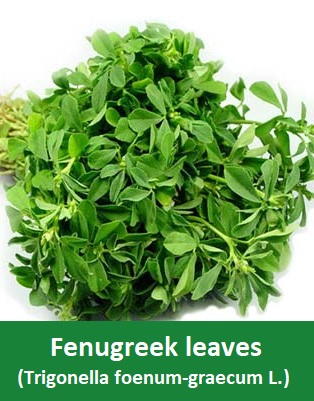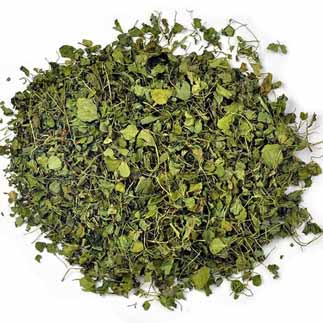Fenugreek leaves (Methi) Nutrition facts
Fenugreek leaves, also known as methi in India, is a culinary herb in the family of Leguminosae. The herb is native to the sub-Himalayan plains of the Indian subcontinent and Southern Europe, where it is cultivated for its leafy greens and dry seeds.
Fenugreek leaves are highly aromantic, and the whole plant exudes a characteristic but mild, tangy flavor.
Scientific name: Trigonella foenum-graecum L, family name Leguminosae (Fabaceae).
 |
Fenugreek is a small, annual leguminous herb. It prefers a cool climate supplemented by well-drained, sandy/loamy soil to flourish. In Northern India and Pakistan, where it is cultivated as a winter season crop (Rabi crop), the seedling is done in late October or November months.
Fenugreek grows to about 12-18 cm in height with light green, tri-foliate, oval leaves with toothed margins. Stems are smooth, tough, and hollow. White flowers appear after about 45 days of the seedling. So, farmers plan the timing of harvest for fresh greens before flowering. In about 28 to 42 days, fenugreek leaves can be picked for use.
Snip off the top one-third of the leaves from each plant using a paring knife twice a week. Continue to harvest the fenugreek greens until the plants start growing flowers. Once the plant starts flowering and seed pods, its leaves acquire bitter and stems become tough and unappetizing.
If left to grow on, the plant bears numerous long, slender seed pods, with each pod enclosing 10-20 hard, yellowish-brown, and angular seeds. The dried seeds have been traditionally used in India, China, Egypt, and some parts of Europe for their beneficial health effects and in traditional medicine.
Health benefits of Fenugreek leaves
Fenugreek leaves are the storehouse of many phytonutrients that have health promotional and disease prevention properties.
The herb is very low in calories (49 cal per 100 g raw leaves) and fats, but a rich source of dietary fiber and is recommended in cholesterol-controlling and weight reduction programs.
Fresh Fenugreek greens are an excellent source of several vital antioxidants and minerals like vitamin C, vitamin A, vitamin E, carotenes, calcium, iron, magnesium, potassium, selenium, and manganese.
Soluble and insoluble dietary fiber content in the leaves aids in digestion and smooth bowel movements. Fenugreek also helps in decreasing serum triglycerides and LDL-cholesterol levels.
Fenugreek greens also contain certain chemicals that function as insulinotropics (aid in insulin production). Also, these greens are one of the low glycemic index food items. Research studies suggest that regular consumption of fenugreek helps in the overall reduction of serum glucose levels in Type-2 diabetes patients.
The leaves are excellent sources of vitamin K. Vitamin K has a potential role in bone mass strengthening by promoting osteo-trophic activity in the bone. It also has an established role in the cure of Alzheimer's disease by limiting neuronal damage in the brain.
Fresh leaves are also a very good source of folic acid. This vitamin has an important role in DNA synthesis, and when given early pregnancy, it may help to prevent neural tube defects in newborns.
Fenugreek leaves in the diet help to prevent osteoporosis, and iron deficiency anemia and are believed to protect from cardiovascular diseases, asthma, and colon and prostate cancers.
The fenugreek seeds have been traditionally used in India, China, Egypt, and some parts of Europe for their beneficial health effects and in traditional medicines as a galactagogue (help in milk secretion in nursing mothers, antibacterial, anti-inflammatory, insulinotropic, and rejuvenating effects.
| Principle | Nutrient Value | Percent of RDA |
|---|---|---|
| Energy | 49 Kcal | 2.5% |
| Carbohydrates | 6 g | 4.6% |
| Protein | 4.4 g | 7.5% |
| Total Fat | 0.9 g | 4.5% |
| Cholesterol | 0 mg | 0% |
| Dietary Fiber | 1.1 g | 2% |
| Minerals | ||
| Calcium | 395 mg | 39.5% |
| Iron | 1.93 mg | 24% |
| Phosphorus | 51 mg | 7% |
Buying and storage
Fresh fenugreek is available in the farmer's markets from late November till early March. However, dried methi leaves (kasuri-methi) can be readily available in protective packs all around the year.
While buying, look for light green, tender leaves. Avoid greens with flowers as their leaves are tough and bitter to taste. Discard any yellow, bruised, wilted leaves and tough stems before storing.
Keep the herb as you do for other greens like arugula, spinach, purslane, kale, etc. Place it in the vegetable compartment of the refrigerator, and set it at high relative humidity.
Kasuri methi is dried fenugreek leaves. It is popular in India and Pakistan for its distinctive and spicy aroma.
It is chiefly used as a condiment in stew and curries in many Northern states of India, Iran, and Pakistan. Generally, it is toasted and crushed before adding to stews to bring out a special flavor and aroma.
Store it in the refrigerator, in an airtight jar, away from moisture. If kept so, kasuri-methi can stay well for up to six months.
Preparation and serving methods
In India and Pakistan, fresh field-grown fenugreek is often sold in the local markets in bushels. Trim the tough stems. Discard yellow, bruised leaves.
Place the leaves in a large colander and clean thoroughly in cold running water as you do it in cases of other greens like spinach in order to remove sand, soil, dirt, etc. Drain water, and gently mop-dry using a moisture-absorbent cloth before use in cooking.
 |
| Kasuri methi. |
Here are some serving tips:
The fenugreek leaves, called methi, are widely used either fresh or dried in Indian cooking and often combined with vegetables such as spinach, potato, and yam.
Aloo-methi (potato-methi leaves) is a favorite winter season stew in Pakistan and the Indian states of Punjab, Bihar, and Rajasthan.
Fresh greens are also used in soups, curries, and cooked in rice dishes like pulov, methi-rice, etc.
Fenugreek greens are an important ingredient in vegetable and dal (pulses) dishes eaten in the rural parts of India.
Dried fenugreek leaves (Kasuri Methi) are generally used as a condiment for flavoring various curries and sabzis.
Dried leaves are used as seasonings to enhance the flavor of Iranian ghormeh sabzi. Other main ingredients here are a mixture of sauteed herbs, consisting of parsley, leeks or green onions, coriander, kale, and yellow split peas.
≻≻-You may also like to read:
≻≻-Fenugreek seeds nutrition facts.
≻≻-Mustard greens nutrition facts.
≻≻-Spinach nutrition facts.
≻≻-Back to Vegetables from Fenugreek leaves (Methi). Visit here for an impressive list of vegetables with complete illustrations of their nutrition facts and health benefits.
≻≻-Back to Home page.
Further reading:
Gopalan et al. 1989 table 1- Nutritional values of Indian Foods.
Production technology of fenugreek (Trigonella foenum-graecum L.)-PDF